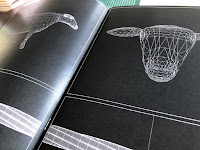This is the final outcome that I produced for SB1 mapping. After experimenting with screen printing I've realised that although it does create a very nice handmade texture to it with the inks used, somehow I didn't feel like it fully represented the concept and intent of the map itself. As I wanted the production method to be part fo the experience of the map I needed something that can enhance that feeling, within the constraints of the exhibition.
I thought creating an A2 vinyl map poster that will be stuck on the walls on the exhibition will be a great way of integrating it's use and intent as well as it's initial impact to the audience. It will also be accompanied with a pair of feet vinyl stickers that will be stuck on the floor adjacent to the map sticker. I thought that by having it as a sticker rather than just a poster will give it a better sense of prominence around pieces which may be in a form of posters or object. As well as that with the help of the feet stickers it will effectively indicate to the audiences that it's meant to be an interactive map that they could try and learn. Furthermore, to further emphasise this I've added instructions on the map as well as a brief rationale of what it's all about.
In order for the audience to learn it easily without context or any long-winded instructions, I've decided to lessen the drawings to the key aspects of the dance that the audience need to learn. In addition, I also added minimal text instructions and emphasised the movements through the usage of lines and curves to indicate direction and with details such as angles and degrees noted, I think that it's effective enough for audience to not get confused or totally frustrated to learn from the map.
Again, the usage of the colour yellow was to emphasise the design itself and help it stand out, as well as help it with concentration as it isn't too distracting nor dull for the audience to look at it for a long time. Additionally, I've used contrasting types (Nimbus sans - sans serif) and Pitch (serif). I've used both types in previous modules and thought that they work really well in complimenting the style and tone of a design. I thought especially with pitch it adds a subtle soft and playful characteristic which reflects the intent and look of the illustrations. And, Nimbus sans helps solidify the instructions making it totally reliable and helpful for the audience.
Overall, I think that the map is effective and successful in its intend to map out a dance choreography and making it possible for the audience to learn and follow the dance through the illustrations n instructions. I think that I've made it simple but exciting enough for the audience. Furthermore, I think that creating it as a set will help showcase the interactive aspect of it whilst in the exhibition and people will actually try it out whilst they're there.
However, if I was to make this better and more successful, I think possibly having the music go with the choreography may make it better? Having the audio may encourage the audience more, and providing them with the beat and melody to follow from may give them that little bit more detailed aid that will help them successfully follow the map. As it is a static map, having an audio player may be a bit of a hassle, therefore I could put it as a QR code that the audience can scan leading them to the song, to Youtube or Spotify. This was as well it's convenient for the audience as they have the music themselves, so they can alter which bit they are or change the speed or put it on loop etc as well as using headphones for a full personal experience.





































